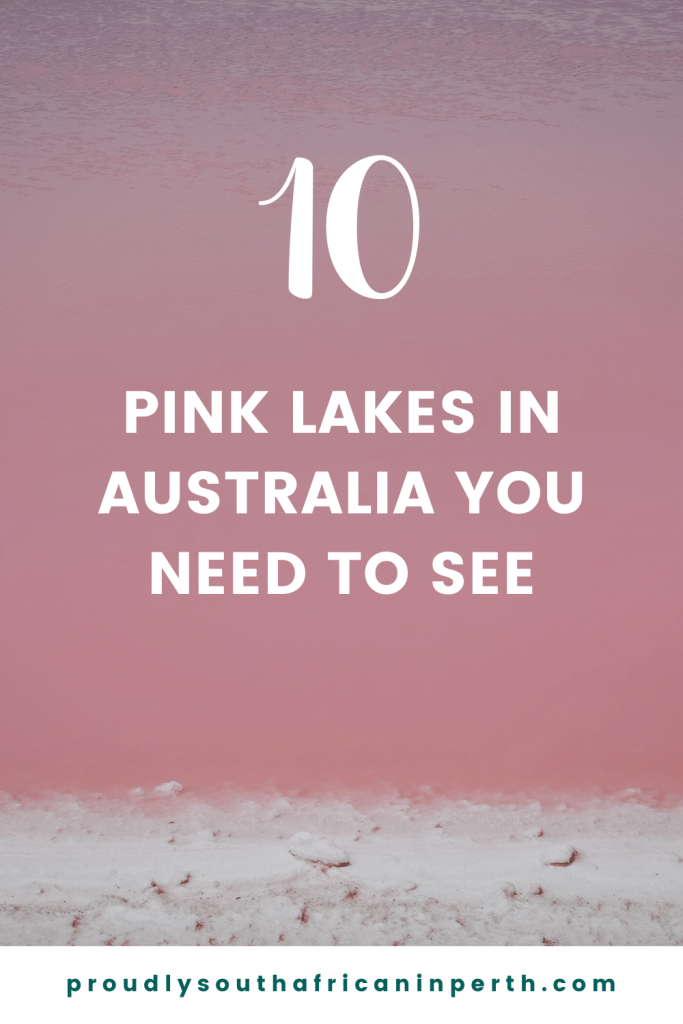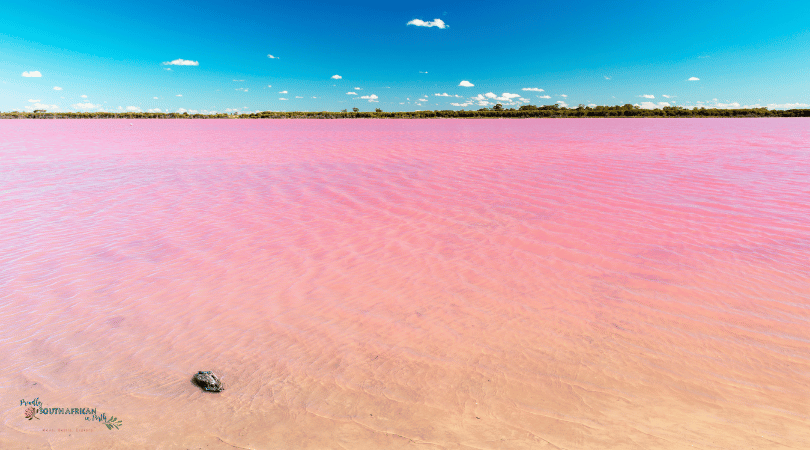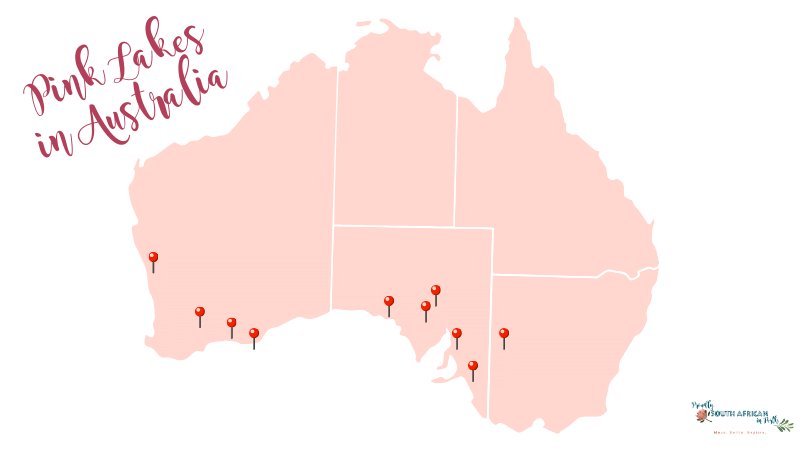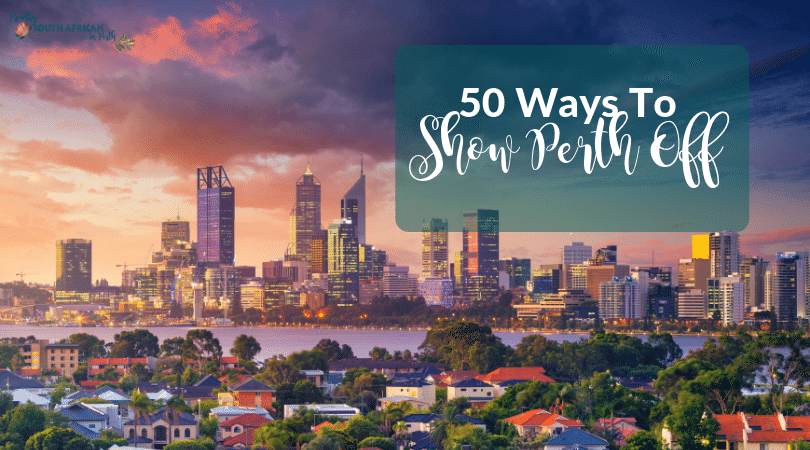Did you know there are dozens of pink lakes in Australia?
Find out everything you need to know about the most breathtaking pink lakes in Australia that you NEED to see!
Where Are There Pink Lakes In Australia?
While there are pink lakes on virtually every continent around the world, Australia is blessed with more than its fair share and is often regarded as the pink lake capital of the world.
Although pink lakes exist in several Australian states, the most stunning ones are scattered across WA, South Australia and Victoria.
Let’s take a look at some of the most breathtaking pink lakes in Australia you need to see.
What Makes The Pink Lakes In Australia Pink?
So what makes the lakes pink in the first place?
The main thing that turns lakes pink is salt. Most of Australia’s pink lakes have a salinity level up to 10 times of that of sea water and even higher than that of the Dead Sea in Israel.
The high salt content produces a vast concentration of salt-loving bacteria and algae species which are all rich in the beta-carotene pigment, the same pigment that gives carrots their bright orange colour.
In certain climatic conditions these microorganisms multiply exponentially to the point of turning the water pink and transforming the lakes into a magnificent kaleidoscope of colour. Basically, it’s just nature showing off its amazing artistic skills.
One thing I have not as yet worked out, is why the Dead Sea in Israel is never pink, despite its exceptionally high salt content, which is similar to the pink lakes of Australia. Anyone know? Tell me in the comments please!
Are The Pink Lakes In Australia Pink All Year Round?
Not all of them. The majority change their hue from a dull darkish brownish-green, or rust to glistening white, soft pastel pink and even bright shocking pink bordering on blood red at times. Lake Hillier situated on Middle Island off the southern coastline of WA, remains bright pink all year round, making it a popular tourist destination despite the difficulty you’ll face getting to it.
Rainfall and weather conditions also affect the hue of the water and may vary from lake to lake. Some are best seen in direct sunlight around midday, while others are most beautiful during sunrise or sunset. The Pink Lakes in the Murray-Sunset National Park in Victoria, are actually best seen under some cloud cover.
It is best to do some quality research before venturing to any of Australia’s pink lakes to ensure you view them in their preferred conditions and dressed in their best outfits. Some are difficult to access so careful planning is required – you do NOT want to be stranded in the outback due to poor preparation!
The Best Pink Lakes In Australia
Lake Albert (South Australia)
Situated along the Murray River just south of the larger Lake Alexandrina, the splendour of Lake Albert is easily accessible and best viewed from anywhere along the Princess Highway. Surrounded by the wetlands, sand dunes, glorious beaches and salt pans of the Coorong National Park, it makes for the perfect stop over to enjoy the diverse natural beauty of this region.
Apart from taking in the pink waters of the lake, the area also offers great outdoor activities in the form of kayaking, hiking, fishing and 4×4 rides along the beaches.
How to get to Lake Albert:
Lake Albert lies less than two hours’ drive southeast from Adelaide, making it a perfect day trip from the city.
Lake Bumbunga (South Australia)
Staying around Adelaide, but in the opposite direction, Lake Bumbunga is another must-see natural wonder of South Australia. The lake is about 9 kms long and 2 kms wide and one can drive around its entire shoreline to capture its beauty from different viewing points. There is a photo-frame on the southern end, which is a favourite spot for Instagrammers.
The lake is fairly shallow and is best viewed around midday in sunny weather, but some cloud cover provides also interesting variations for photographers. If you’re planning to stay there for a while, accommodation is available all around and nearby Clare where you can enjoy the famous wines of the region.
How to get to Lake Bumbunga:
Lake Bumbunga lies about 90 minutes’ drive north of Adelaide along the A1 passing through the small town of Port Wakefield.
Lake MacDonnell (South Australia)
Tucked away on South Australia’s shoreline in the middle of nowhere, Lake Macdonald is another pink lake gem no one should miss when passing through this region. The beauty of this lake is that it’s so remote and you can drive across the lake on a dirt road with a lake on either side. If there are a few inches of water, one side will be vibrant pink and the other bluish green. When it is completely dry, the thick salt crusts are blinding white. The dirt road bisecting the lake provides excellent spots to photograph the two contrasting sides.
The lake forms part of the largest gypsum mine in the southern hemisphere. If you feel like having a dip, the refreshing blue waters of the Southern Ocean are a few minutes away at the end of the track. A word of warning though, it’s not a good place to breakdown as there is absolutely no signal here.
How to get to Lake MacDonnell:
The lake lies about 10 hours’ drive northwest of Adelaide along the A1 through Port Augusta and 20 kms south of the small town of Penong which provides a great stop over.
Lake Hart (South Australia)
Situated up north in the middle of the outback of South Australia, Lake Hart is another Australian pink lake certainly worth visiting. Its remoteness and lack of any services is its biggest drawcard, attracting campers by the lakeshore, who enjoy spending magical nights under the stars, next to the pastel pink lake. Sunrises and sunsets are truly unforgettable here.
It’s a seasonal lake but even when it’s dry, the white salt crystals in the bed glisten in the sun like chips of ice creating a surreal almost otherworldly scene.
How to get to Lake Hart:
Lake Hart lies about 500 kms northwest of Adelaide. You can drive there along the A1 to Port Augusta and then take the A87 all the way past the lake. The journey by car usually takes about 6 hours. It can also be seen from aboard the Indian Pacific train that runs straight past the lake on its way between Sydney and Perth – something that’s definitely on my Australian travel bucket list!
Lake Eyre (South Australia)
The good thing about Lake Eyre, is that when it is full it is one of the largest pink lakes in Australia and a sight to behold. The bad thing about it though, is that it only fills up every 3 to 10 years and is mostly a vast bed of glistening white encrusted salt deposits.
Located amidst an arid landscape when the rains fill the salt basin from the adjoining mountains, it bursts into life in more way than one, making it a bucket list for many nature lovers. Not only is the barren land transformed into a kaleidoscope of all shades of pink, turquoise, gold and lush greenery, but it also becomes a haven for birds like ducks, cormorants and even seagulls. This magical show is best viewed from the air and one can book scenic flights from William Creek a few kms to the west of the lake.
How to get to Lake Eyre:
Lake Eyre is at least an 8 hour’s drive almost north of Adelaide. It can also be reached by air with flights taking about 1.5 hour.
Hutt Lagoon (Western Australia)
One of Australia’s most gorgeous pink lakes lies on the WA coast about 6 hours north of Perth. Being 15 kms long and 2.5 kms wide and fringed by red cliffs and the clear blue ocean, the vibrant pink waters of Hutt Lagoon make a spectacular sight especially when viewed from the air. It’s truly a drone photographer’s dream.
The waters are at their most vivid around midday, but constantly change throughout the day from a subtle pink to deep red, depending on the sun and cloud cover. During the hot and dry summer months, the lake dries out losing its deep pink hue somewhat, but one can then walk in the lagoon and take spectacular photos, although it can be a little slimy. In winter the rains fill the lake and it regains its vibrant bubble-gum pink colouration.
A 4×4 vehicle would be a great advantage to view the lake from various vantage points, but you could also take a buggy tour around the lake, to view some of the local wildlife and learn about the region’s history too. Taking a scenic flight over the lake is perhaps the ultimate thrill here. Accommodation is available at the nearby Port Gregory Caravan Park.
We drove through on our road trip to Kalbarri a few years ago and this was the first pink lake we’d ever seen. It’s a pretty remarkable sight and one I will never forget.
How to get to Hutt Lagoon:
You could take the safer Brand Highway from Perth or the more scenic Ocean Drive going through spectacular scenery, including the Nambung Nature Reserve with its enigmatic pinnacles. If you’re travelling during the wildflower season (July-Oct) be prepared for another one of nature’s spectacles. Once you reach Northampton, veer left along the Port Gregory Road for about 40 kms, and you’re there.
Lake Hillier (Western Australia)
Situated on Middle Island about 10 kms off the south coastline of Western Australia, Lake Hillier is the most photographed and most radiant pink lake in Australia and possibly in the world. Its shocking pink hue contrasts the surrounding lush green vegetation of the island which itself is encircled by the crystal blue waters of the Southern Ocean – a stunning, stunning sight from the air. Despite the difficulty and costs of getting there, it’s no surprise, Lake Hillier is a popular destination for so many visitors.
Unlike several other pink lakes, which tend to change their hue, depending on weather conditions, Lake Hillier maintains its vibrant hue almost all year round in most conditions. Visiting by boat or helicopter, you can set off on foot through the wooded landscape exploring the camp ruins of Black Jack Anderson, Australia’s only true pirate who terrorised ships during the 19th century, before trudging your way to the spectacular shores of the lake.
How to get to Lake Hillier:
The only ways of getting to Lake Hillier is by boat or by air, both of which can be booked at Esperance.
Pink Lakes & Rainbow Lakes (Western Australia)
While you’re in Esperance, the Pink Lake situated a few kms from the town centre is certainly worth a visit. Unfortunately this pink lake has lost its vibrant pink hue over the years and today it is a soft powdery like whiter shade of pink, but still beautiful enough to draw visitors to this region.
Unlike the spectacular Lake Hillier, in which you’re not allowed to swim, you can swim in this lake. A road runs along most of its shoreline with benches to rest and take in the sight. Warden Lake and the Woody Lake Nature Reserve lie virtually next to Pink Lake, where one could go on a walking trail round the series of lakes.
How to get to Pink Lakes & Rainbow Lakes:
To get to the Pink Lake at Esperance, all you have to do is follow the (you guessed it) Pink Lake Road from the town centre.
Quairading Pink Lake (Western Australia)
Not spectacular by any means, and not always pink but easily viewed from along the Bruce Rock Quairading Road that bisects the lake. The lake which is only a few hundred metres wide, may vary from a greenish-brown, rust or a few shades of pink depending on the season and conditions, so you may end up being a little disappointed.
Not a place to specifically set out to see, but certainly worth a stop and look if you’re driving from Perth to Esperance or to the more famous Wave Rock about 70 kms away.
How to get to Quairading Pink Lake:
Quairading Pink Lake lies about 200 kms west of Perth and 10 kms out from the small town of Quairading.
Pink Lakes (Victoria)
Tucked within the massive Murray-Sunset National Park in the north-western corner of Victoria, a series of four pink lakes add intrigue and beauty to this rugged and wildlife-filled landscape. Unlike some pink lakes, which are best seen in bright sunlight, for some reason, these lakes are best viewed when there is some cloud cover. Their hue constantly changes from a glistening silver white or milky pink to a deep vivacious pink.
There are miles of walking tracks around and between the lakes with two campsites, to stay over and explore the local wildlife.
How to get to Pink Lakes:
Pink Lakes lie about 440 kms northwest of Melbourne six hours drive away and only about 320 kms due east of Adelaide.
So, now it’s time to hit the road and start exploring these incredible pink lakes of Australia! Have you visited any yet? Which ones have impressed you the most? Let me know in the comments below, and feel free to add any ones I might have missed in this list.








No Comments